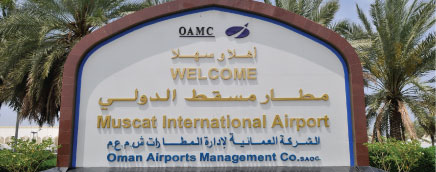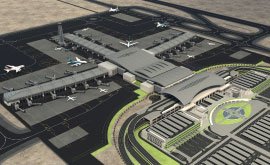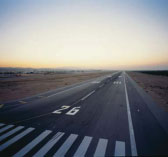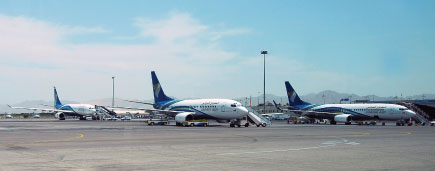
According to a recent World Travel and Tourism Council study, travel and tourism is expected to account for 9.9% of Oman's GDP by 2019.
The various projects that are currently ongoing at Muscat International Airport make up the first stage of a master plan that has been developed to cater for the continued increase in tourism-generated traffic.
While more than 4.5 million passengers passed through the airport in 2009 – almost a 14% increase on the previous year – the first six months of 2010 have seen passenger numbers increase by a further 29%, while in the same period, the total number of civil aircraft movements increased by 30%.
With the growth rate expected to continue, OAMC is now taking steps to ensure that demand doesn’t outstrip the airport’s capacity and upon the opening of the new terminal, total capacity will be increased from five million to 12 million annual passengers.

The new terminal at Muscat International Airport is due to open in 2014 and will increase the airport's capacity to 12 million passengers.
The project started in 2007 with the renovation and refurbishment of the terminal building, which included the full internal and external painting and panel decoration, the installation of new carpets and handrails, the installation of a laminated lighting system and coloured spot lights system, and the construction of a new canopy for the international arrivals main entrance.
Al-Harthy explained: “In 2009, we extended the departures area, which included the addition of eight new departure gates, a new seating area, smoking room, children’s play area, a prayer room and new commercial and retail shops.”
Other areas of the terminal have also been expanded recently, primarily to increase circulation and queuing space, improving the passenger experience. The landside departure hall and queuing area for hold baggage security screening were extended to create an extra 700sqm of space.
More recently, the check-in hall in departures has undergone an extension of 1,200sqm to provide for an additional 20 check-in counters, taking the airports total number of check-in desks to 58. This increases the airport’s check-in capacity by 53%.
In addition, six new aircraft stands have also been added, while the baggage claim hall at arrivals has also been expanded by 30% and the three baggage belts have been upgraded.
New terminal
The flagship aspect of the overall Muscat International Airport development is the construction of the new terminal, which also includes a new air traffic control tower, an Air Traffic Management Centre and a second runway, capable of handling the Airbus A380. Meanwhile, the existing runway will also be upgraded to allow it to also cater for next-generation aircraft.

A second runway is currently under construction at Muscat International Airport, while the current runway is also being upgraded to enable it to handle next generation aircraft.
Covering a gross floor area of 330,000sqm, the new terminal will feature 29 boarding air bridges, extensive commercial facilities and an 80-bed airside hotel. A cargo terminal capable of handling 260,000 tonnes of cargo annually and car parking facilities for 6,000 cars will also be introduced.
However, before construction could begin, a complex site preparation programme had to be undertaken to provide adequate drainage of the flat, low-lying site of the new runway.
To eradicate the risk of flooding, between 10-12 million cubic metres of desert sand and crushed rock was used to raise the ground by three metres and in order to protect the rest of the airport and surrounding residential properties from flood surges, three giant culverts have also been installed to the Bay of Oman.
Inbound potential
OAMC’s decision to redevelop and expand Muscat International Airport, as well as Salalah Airport and a number of other domestic airports within the Sultanate of Oman – including Sohar, Ras al Hadd, Adam and Al Duqm airports – has been largely inspired by the recent boom in inbound tourism.
This sharp increase in tourism was highlighted in a recent report by the World Travel and Tourism Council, which outlined that the contribution of travel and tourism to gross domestic product (GDP) is expected to rise from 6.7% in 2009, to 9.9% by 2019.
Al-Harthy said: “The tourism industry in Oman is growing but at the moment the hotels are limiting this due to a shortage of rooms. By 2014, when the new terminal is scheduled to open, hotel rooms will have increased quite significantly and this goes hand-in-hand with all of our airport projects.
“Of course, we’re not aiming to compete with the likes of Dubai. Our aim is for Muscat to be the hub of Oman and to continue to be the base for Oman Air; what we’re creating is a niche market for tourism to Oman.”
While the current developments should be complete over the course of the next four years, OAMC also has a more long-term master plan in place, which lays out the strategy for the airport right up until the year 2050.
“This is divided into two separate stages,” Al-Harthy explained. “If the demand exists, the master plan will allow for the airport to expand to a capacity of 24 million passengers. It’s difficult to say exactly when this might be as it depends entirely on passenger demand. The second phase is that by 2050, again, if the demand is there, the master plan will allow for the airport to be further developed to be able to handle as many as 48 million annual passengers.”

Al-Harthy: "Our aim is for Muscat to be the hub of Oman and to continue to be the base for Oman Air."







